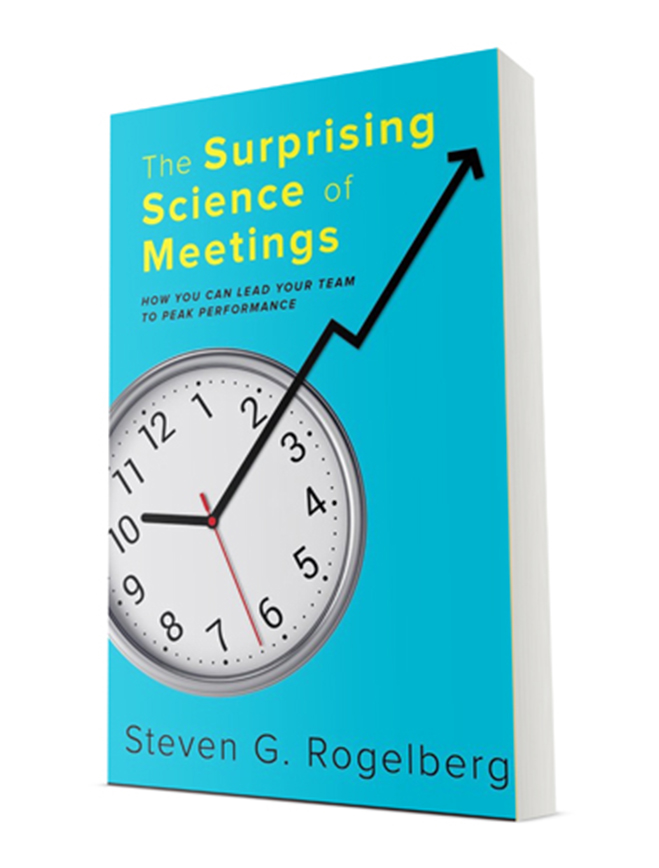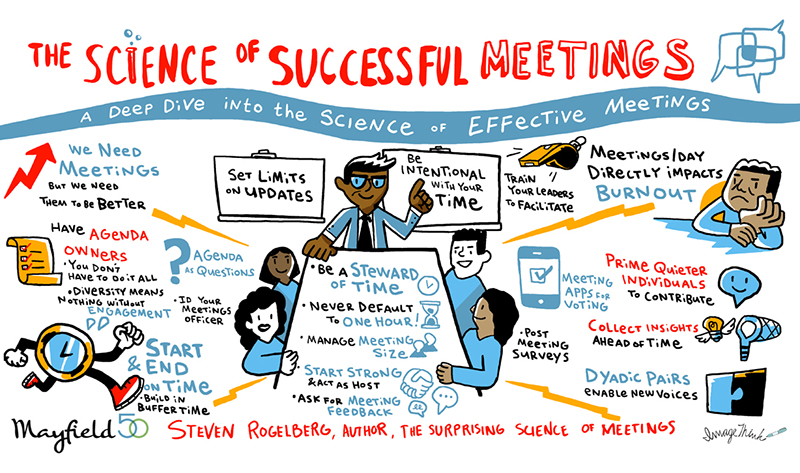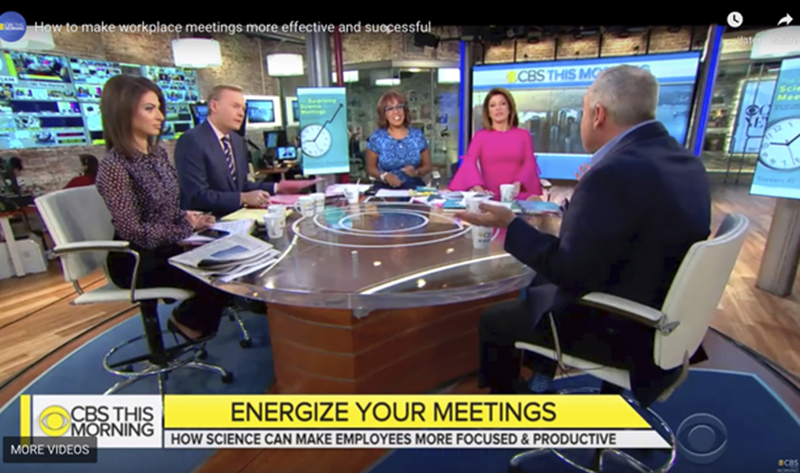
Run Better Meetings
Local author and company leaders share strategies
By Andrea Cooper
You bound out of bed and skip your usual cup of caffeine, so excited by the prospect of a fascinating workday filled with meetings.
Yeah — well, no. No one is joyful about meetings. Some of us loathe them, which makes it more surprising that some 55 million meetings occur every day in the U.S., according to meetings expert Steven Rogelberg. Just as remarkable, he says: Meetings don’t have to be awful. They can be catalysts for cooperation, creativity and innovation.
A south Charlotte resident and professor of organizational science, management and psychology at UNC Charlotte, Rogelberg has written “The Surprising Science of Meetings: How You Can Lead Your Team to Peak Performance.” The Washington Post called it the “#1 leadership book to watch out for in 2019.”
Rogelberg also has appeared as a guest on “CBS This Morning” with Gayle King, an experience he describes by turns as “incredibly nerve-wracking,” “exhilarating” and “surreal.” He also has given a talk at Google and has consulted for Family Dollar, Procter & Gamble and others.
The attention to Rogelberg’s work demonstrates how much people want meetings to be better. “We expect people who manage people or projects to suddenly know how to run a meeting. Most of us don’t know how to do that effectively,” says Ballantyne-based health care consultant Lane Ostrow, who uses Rogelberg’s ideas for improving meetings.
Rogelberg says there are one to two people who typically think a meeting went well: the person who ran it and the person who talked the most. Meetings are beneficial only 50 percent of the time, he says, and across the globe, people cite “too many meetings” as their top timewaster at work.sed today’s IT career trajectory and what the latest generation of technological advances bodes for us professionally and personally.
What’s the Fix?
Drawing upon more than two decades of his research on meetings, Rogelberg offered ideas in a recent interview with Ballantyne Magazine and in a public talk at the Levine Jewish Community Center in Charlotte, starting with:
Lead with intentionality.
The best meeting leaders realize they are a steward of others’ time. They think carefully about who needs to be there, what needs to be discussed and the best way to conduct the meeting. They look at employees as customers.
Manage meeting size.
“As meetings increase in size, so does dysfunction,” Rogelberg says. Keep your meetings under eight participants, preferably. You want active participants, not spectators. Consider inviting some employees for just part of the meeting.





Don’t assume you need 60 minutes.
It’s the default setting with Outlook, Apple and Google calendars, but that’s not a good reason to insist on an hour. Rogelberg is fond of citing Parkinson’s Law, which posits that work expands to fill the time allotted to it. If you think you can cover everything in 45 minutes, or better yet, 30 minutes, do it.
Start your meetings well.
A meeting is hardly a cocktail party, but the meeting leader still needs to be a host, Rogelberg believes. Thank people for coming, introduce those who don’t know each other and occasionally, bring snacks.
Mood matters.
People tend to be more open-minded and creative when the collective mood of a meeting is upbeat. “If the leader comes in with a positive state of mind, it tends to be contagious,” Rogelberg says. A change of setting can help. Some leaders, including Twitter cofounder Jack Dorsey and former President Barack Obama, are partial to walking meetings with two or three people.
Evaluate your meetings periodically.
Rogelberg’s most intimidating suggestion may be to ask your employees or colleagues, “How am I doing at meetings?” Ask via an anonymous survey for ideas to make your meetings more effective. Also, here’s a tip: If there are lots of side conversations or people checking their phones during your meetings, things could be going better.

Local Perspective
To see how these and other ideas play out in real workplaces, we talked with two Ballantyne business owners for perspective.
Health care consultant Lane Ostrow was inspired to try Rogelberg’s ideas with a client’s corporate development team, which responded enthusiastically. “I’ve apparently run a lot of bad meetings until now,” Ostrow jokes wryly.
He started framing meetings around questions to be answered rather than agenda topics. That clarifies who needs to be present and for how long, so they don’t have “to sit through a two-hour meeting with 10 minutes of participation,” Ostrow says. (You wouldn’t necessarily use that technique for every meeting, Rogelberg advises, but at a minimum, ask employees what should be on the agenda sometimes and don’t recycle the same agenda from week to week.)
For long meetings, Ostrow invites certain participants to come for just part of the session to sharpen the focus. The meeting pauses as some people leave and others may arrive. Lest you assume the coming and going is disruptive, “the smiles on their faces as they leave are worth it,” Ostrow says.
The pauses are also useful. They give employees time to access important emails or calls — which helps them focus during the meeting when it resumes.
Additionally, participants stay more attentive when meetings are shorter than typical lengths, Ostrow says. He now holds 25- or 50-minute meetings and has found them just as productive, partly because the slight time pressure can motivate participants and inspire more concentrated effort.
By testing new meeting strategies, Ostrow came away believing that improving a company’s meetings can have a bigger impact on productivity and profitability than many of the usual measures a business tracks. Some companies, he points out, will make sure employees stay only at certain hotels to save a few dollars. But the same companies can keep employees stuck in half-day meetings with haphazard attention to the cost of employees being there or outcomes. It’s a major expense, Ostrow argues, with “no one paying attention to it.”
Rishi Bhatnagar has made his discoveries about meetings as CEO of Syntelli Solutions, a Ballantyne-based company that helps businesses analyze and use their data to help predict customer behavior and inform business decisions. His preference is 15 minutes — yes, 15 minutes — for one-on-one meetings with an employee.
His employees research and ponder potential solutions to problems in advance; then, the meeting itself is devoted to discussing pros, cons and next steps. When facing particularly complex situations, Bhatnagar asks the employee to send him a note ahead of time about the purpose of the meeting and decisions to be made.
For meetings with more people, Bhatnagar employs two distinct strategies. He chooses standing meetings to develop tactics or resolve an issue. Standing meetings equal shorter meetings. “We take out that element of comfort or settling in,” he says.
Sometimes comfort is just what you need, though. When Bhatnagar is looking for creativity and innovation in a meeting, he’ll invite everyone to relax in bean bag chairs. An employee might stand at the whiteboard recording ideas while Bhatnagar is among those low to the ground. The relaxed environment promotes a greater feeling of equality, and that’s when, Bhatnagar says, “the creative juices will flow.”
It’s a given some ideas will work in a company’s culture and others won’t, but all these experiences suggest the merits of rethinking meetings. As Rogelberg says, “While we often think of meetings as places of drain, meetings done right can be places of gain.”

